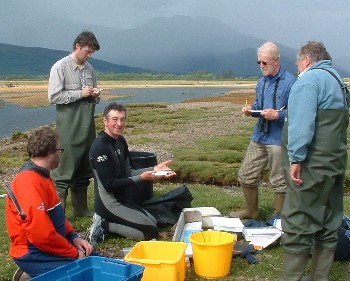Ecology and management of parasitic sea lice reviewed at Gairloch seminar
Posted: Friday 24 April, 2009 @ 16:03:50

The parasitic sea louse Lepeophtheirus salmonis remains a major concern for wild sea trout and salmon fisheries in Wester Ross. On 16th April, WRFT was pleased to welcome other biologists from Marine Scotland and local salmon farming companies, and a range of other people with interests in wild fisheries, salmon farming and the sustainable development of Wester Ross, to Gairloch, to review the latest findings from research projects and management trials.
The meeting was supported by the Scottish Government via the Tripartite Working Group (TWG) and Rivers and Fisheries Trusts Scotland (RAFTS). Arthur Griffiths (TWG Project manager) kindly agreed to chair the meeting and provided an introduction. Dr Campbell Pert (Marine Scotland, Marine Lab) described the biology and life cycle of the two species of sea louse most commonly found in Scottish coastal waters, referring to scanning electron microscope images. Sentinel cage experiments in Loch Torridon stocked with sea trout provided information on rates of infection. The results suggested that in 2007, it would have taken 6 weeks for the stocked fish to become infected with 50 or more lice. Jim Raffell (Marine Scotland, Shieldaig Project) summarised findings from planktonic larval lice sampling in Loch Torridon. There was a correlation between larval lice concentrations along the shoreline and lice numbers on nearby farms. The bulk of sea lice on sea trout fished from the lower Shieldaig River in 2007 were early stage lice indicative of recent infection. Jim stressed the importance of treatment synchronisation on nearby salmon farms as a means of controlling sea lice within the local area.
Dr Michael Penston (Marine Scotland, Marine Lab) presented the results of plankton tows in Loch Torridon. Local salmon farms were sources of larval lice in 2007. Modelling indicates that lice dispersal is dependent upon wind direction, and that infective larval lice can be transported several km from source. Peter Cunningham (WRFT) reviewed results of monitoring of sea trout in Wester Ross in 2007 and 2008. Although the highest levels of infection of attached lice (copepods and chalimi) tended to be within 20km of salmon farms in the second year of the production cycle, incorporation of sweep net data from beach sites away from river mouths may have biased this result. In contrast, levels of infection of pre-adult and adult lice showed no relationship with distance to the nearest salmon farm in the 2nd year of the production cycle. Additional existing data sets for sea trout sampled across the west of Scotland are needed to rigorously test the hypotheses presented.
Hugh Richards described how Wester Ross Fisheries use both SLICE and bath treatments for sea lice infection on their farms. Observations suggested fewer jellyfish in the Loch Broom area in 2008 and 2009 than earlier years. Following temperatures of over 1oC above average up to 2006, sea temperatures had returned to near ten year averages in 2007 and 2008. Dr Chris Wallace (Marine Harvest) explained how the use of a new in feed product, SPMP, had increased the efficacy of emamectin benzoate [SLICE] as a treatment for sea lice. Initial trials had indicated good results and from 2009 the product was widely used in conjunction with SLICE to manage lice on MH farms.
A wide-ranging discussion followed, not without some controversial points. WRFT would like to thank all participants, particularly presenters for their much valued input, and especially Arthur Griffiths for chairing a lively meeting.